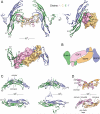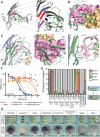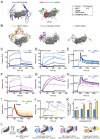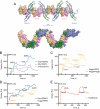Structure of Gremlin-2 in Complex with GDF5 Gives Insight into DAN-Family-Mediated BMP Antagonism
- PMID: 27524626
- PMCID: PMC5001929
- DOI: 10.1016/j.celrep.2016.07.046
Structure of Gremlin-2 in Complex with GDF5 Gives Insight into DAN-Family-Mediated BMP Antagonism
Abstract
The DAN family, including Gremlin-1 and Gremlin-2 (Grem1 and Grem2), represents a large family of secreted BMP (bone morphogenetic protein) antagonists. However, how DAN proteins specifically inhibit BMP signaling has remained elusive. Here, we report the structure of Grem2 bound to GDF5 at 2.9-Å resolution. The structure reveals two Grem2 dimers binding perpendicularly to each GDF5 monomer, resembling an H-like structure. Comparison to the unbound Grem2 structure reveals a dynamic N terminus that undergoes significant transition upon complex formation, leading to simultaneous interaction with the type I and type II receptor motifs on GDF5. Binding studies show that DAN-family members can interact with BMP-type I receptor complexes, whereas Noggin outcompetes the type I receptor for ligand binding. Interestingly, Grem2-GDF5 forms a stable aggregate-like structure in vitro that is not clearly observed for other antagonists, including Noggin and Follistatin. These findings exemplify the structural and functional diversity across the various BMP antagonist families.
Copyright © 2016 The Author(s). Published by Elsevier Inc. All rights reserved.
Figures




References
-
- Bragdon B, Moseychuk O, Saldanha S, King D, Julian J, Nohe A. Bone morphogenetic proteins: a critical review. Cell. Signal. 2011;23:609–620. - PubMed
-
- Brazil DP, Church RH, Surae S, Godson C, Martin F. BMP signalling: agony and antagony in the family. Trends Cell Biol. 2015;25:249–264. - PubMed
-
- Cahill E, Costello CM, Rowan SC, Harkin S, Howell K, Leonard MO, Southwood M, Cummins EP, Fitzpatrick SF, Taylor CT, Morrell NW, Martin F, McLoughlin P. Gremlin plays a key role in the pathogenesis of pulmonary hypertension. Circulation. 2012;125:920–930. - PubMed
MeSH terms
Substances
Grants and funding
LinkOut - more resources
Full Text Sources
Other Literature Sources
Miscellaneous

